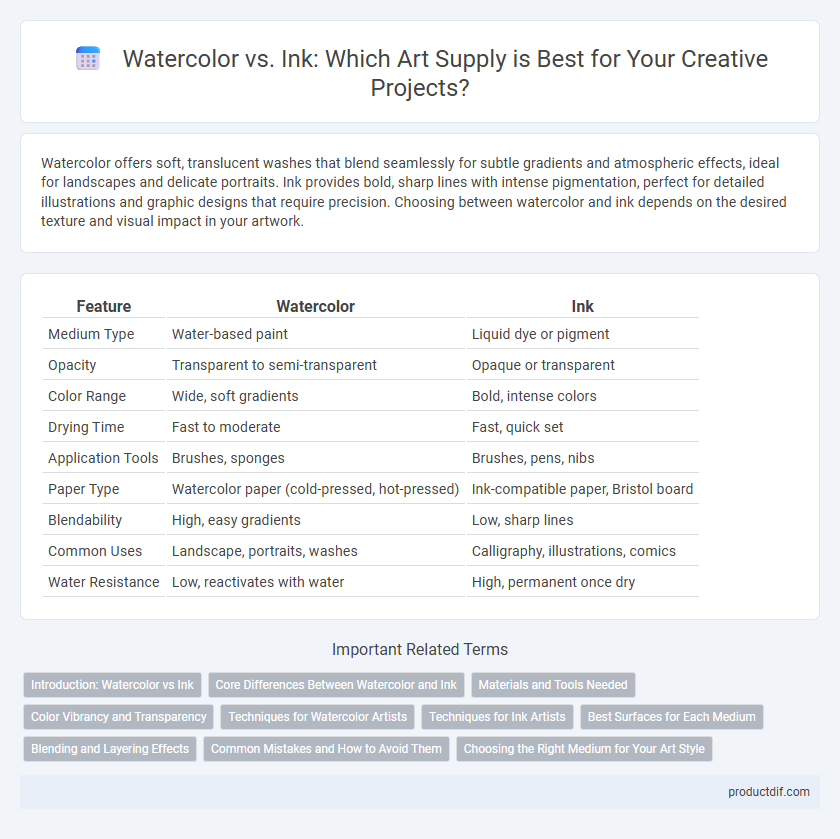Watercolor offers soft, translucent washes that blend seamlessly for subtle gradients and atmospheric effects, ideal for landscapes and delicate portraits. Ink provides bold, sharp lines with intense pigmentation, perfect for detailed illustrations and graphic designs that require precision. Choosing between watercolor and ink depends on the desired texture and visual impact in your artwork.
Table of Comparison
| Feature | Watercolor | Ink |
|---|---|---|
| Medium Type | Water-based paint | Liquid dye or pigment |
| Opacity | Transparent to semi-transparent | Opaque or transparent |
| Color Range | Wide, soft gradients | Bold, intense colors |
| Drying Time | Fast to moderate | Fast, quick set |
| Application Tools | Brushes, sponges | Brushes, pens, nibs |
| Paper Type | Watercolor paper (cold-pressed, hot-pressed) | Ink-compatible paper, Bristol board |
| Blendability | High, easy gradients | Low, sharp lines |
| Common Uses | Landscape, portraits, washes | Calligraphy, illustrations, comics |
| Water Resistance | Low, reactivates with water | High, permanent once dry |
Introduction: Watercolor vs Ink
Watercolor and ink are popular art supplies with distinct characteristics and applications. Watercolor offers translucent, blendable pigments ideal for creating soft gradients and natural textures. Ink provides bold, permanent lines and vibrant color intensity suited for detailed illustrations and graphic designs.
Core Differences Between Watercolor and Ink
Watercolor paint is composed of pigment suspended in a water-soluble binder, producing transparent layers that blend smoothly and allow for subtle color gradations. Ink, often made from dyes or pigments in a liquid solvent, delivers intense, opaque lines and vibrant saturation with sharper edges and quicker drying times. The core differences revolve around their fluidity, blending techniques, and overall finish: watercolor emphasizes softness and translucency, while ink prioritizes precision and bold contrast.
Materials and Tools Needed
Watercolor painting requires high-quality watercolor paints, textured paper designed to absorb water, and a variety of brushes like round or flat sable brushes for precise control and blending. Ink artwork utilizes materials such as India ink or pigment-based waterproof inks, specialized nib pens or brushes for line work, and smooth, bleed-resistant paper to ensure sharp, defined strokes. Both mediums demand different preparation and handling techniques to maximize their unique visual effects and durability.
Color Vibrancy and Transparency
Watercolor offers delicate transparency and soft color gradients, ideal for layering and achieving luminous effects. Ink provides intense color vibrancy with bold, saturated tones that stand out on paper, often used for sharp, graphic details. Both mediums excel in different ways, with watercolor favoring subtle lightness and ink emphasizing vivid opacity.
Techniques for Watercolor Artists
Watercolor artists often utilize layering and glazing techniques to build depth and luminosity, achieving subtle color transitions through controlled water application. Ink can complement watercolor by adding fine details and strong contrast with techniques like hatching, cross-hatching, and stippling, enhancing texture and definition. Mastering the interplay between fluid watercolor washes and precise ink lines expands creative possibilities for mixed-media artworks.
Techniques for Ink Artists
Ink artists often use techniques such as hatching, stippling, and wash to create depth and texture, employing both dip pens and brushes for varied line quality. Unlike watercolor's fluid blending, ink demands precision in layering and controlling drying times to build contrast and intricate details. Mastering techniques like feathering and blotting enhances the expressive potential of inks in fine art and illustration.
Best Surfaces for Each Medium
Watercolor performs best on textured, absorbent surfaces like cold-pressed or rough watercolor paper, which enhance pigment flow and color blending. Ink excels on smooth, non-absorbent surfaces such as Bristol board or hot-pressed paper, allowing for crisp lines and sharp details without bleeding. Selecting the right surface maximizes the unique qualities of each medium and improves the durability of the artwork.
Blending and Layering Effects
Watercolor offers smooth blending with translucent layers that create soft gradients and subtle color transitions, ideal for achieving atmospheric effects. Ink provides sharper layering with more defined edges and intense pigmentation, allowing for precise detailing and bold contrasts. Combining both mediums enhances artwork by leveraging watercolor's fluid blending and ink's strong, layered textures.
Common Mistakes and How to Avoid Them
Watercolor often suffers from overworking areas, leading to muddy colors, while ink mistakes usually stem from smudging or uneven lines due to insufficient drying time. To avoid these issues, artists should use high-quality, absorbent paper designed for each medium and allow proper drying intervals between layers. Employing the right brushes and pens with controlled pressure also helps maintain clean, vibrant strokes essential for both watercolor and ink artwork.
Choosing the Right Medium for Your Art Style
Watercolor offers translucent layers and smooth blending, ideal for artists seeking delicate gradients and subtle color variations. Ink provides bold, sharp lines and intense contrast, perfect for detailed illustrations and graphic styles. Selecting between watercolor and ink depends on your desired texture, control level, and the overall mood you want to convey in your artwork.
Watercolor vs Ink Infographic

 productdif.com
productdif.com